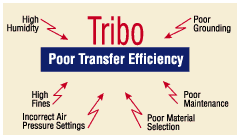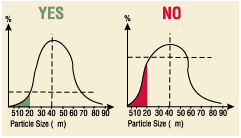Troubleshooting Tribo
Triboelectric charging was the first method known to humanity of producing electrostatic charge...
Tribo-charging has gained a prominent position in powder coating as a method of applying electrostatic charge to powder paint particles. Because triboelectric guns possess a number of distinct advantages, use of this technology in the powder coating market is likely to continue.
As with any piece of equipment, there is a number of factors that can affect the performance of triboelectric spray guns. Understanding these factors will help coaters properly maintain and troubleshoot powder coating lines equipped with tribo guns.
Featured Content
Incorrect pump/gun air pressure settings
In powder coating, more is not better. This statement cannot be repeated too often. However, there is an exception to the rule—tribo-charging guns. The higher the velocity of the powder particles traveling through the gun, the better the charging because of the greater friction between the particles and the gun's charging module. Therefore, the pump and gun air pressure settings should be set to provide a high powder velocity inside the gun at a required powder flow rate.
As always, a tradeoff exists. Greater powder velocity through the gun can result in a high-velocity spray pattern and introduce unwelcome aerodynamic problems. These problems can, in some cases, be resolved by moving the guns farther from the parts, or by using multi-finger spray heads on tribo-charging guns.
Another negative outcome of high powder velocity inside the gun is increased wear on the gun parts. This problem can only be addressed by optimizing the gun design.
Poor material selection
The extent of triboelectric charging between any two materials varies widely based on the type of material used. Most tribo-charging guns on the market have charging modules made of PTFE because most powder paint materials will charge positively from the friction generated by rubbing against it. But, depending on specific material properties, different powders will charge to different extents. Therefore, a careful selection/formulation of powder material is imperative for consistent tribo-charging performance. When spraying PTFE powders, nylon should be used for the charging module of the gun. Some additives intended to improve powder fluidization may coat the tribo-charging surfaces of the gun and inhibit charging.
High humidity
Ever notice that when it is dry outside you are more likely to get a little zap getting out of your car or turning a metal door knob? The reason is simple. Low humidity facilitates tribo-charging. For tribo-charging to occur, it is important that the materials (powder coating and charging surfaces of the gun) rub together. When humidity is high, a thin microscopic film of moisture can form on the charging surface of a gun and even on the surface of powder particles. This inhibits triboelectric charging of the two materials. Therefore, when operating a tribo-charging powder coating line, close attention has to be paid to the humidity level of ambient and compressed air. For best results, it is recommended that ambient air humidity not exceed 50 pct and the compressed air dew point is maintained at no higher than 35F.
High content of fine powder particles. It is important to remember that in a tribo-gun, the powder particles obtain charge by rubbing against the surface of the charging module. The stronger the friction, the better the charge. Coarse powder particles (greater than 30 microns) have a significant mass and, therefore, a great momentum when propelled by the air stream. They impact the walls of a charging module with much greater strength and create greater friction than smaller size particles. Hence, larger powder particles will charge better and have on average higher transfer efficiency in a powder coating spray application.
If this is the case, then in applications where oversprayed powder is reclaimed and returned to a spray system, a greater percentage of fines will be returning. A gradual accumulation of fines occurs, resulting in a reduction of the overall first-pass transfer efficiency.
The level of tribo-charging of the powder will not only depend on the powder material composition, but also on other components dry-blended with the powder.
Poor maintenance
Proper maintenance may even be more important with triboelectric guns than it is with corona-charging guns. Because the charging depends on powder particles' ability to rub against the charging surfaces of a gun, any obstructions inside the gun's powder path (which may occur if the powder path is plugged by agglomerated powder or mechanical contaminants) are likely to have a detrimental effect on charging performance. If parts inside the gun are worn, this may create non-uniform powder flow through the charging module and, therefore, poor charging. In addition, even a thin layer of impact-fused powder on the surface of a charging module will dramatically reduce charging efficiency. All this can be avoided if proper maintenance and cleaning procedures are followed.
Poor ground
Poor grounding of coated parts is a common cause of low transfer efficiency in both corona and tribo-charging powder coating applications. In addition to proper part ground, special attention should be paid to proper grounding of the triboelectric guns themselves. As powder particles rub against the charging surfaces of a gun and acquire charge, they leave a charge of opposite polarity on the gun's parts. This charge should always have an easy path to bleed to the ground. If such a path is not provided, a tremendous accumulation of charge can occur on the gun. In addition to creating fire and personal injury hazards, the improper gun grounding has a detrimental affect on powder charging.
Outlined in this article are some typical causes of an inadequate performance of triboelectric powder spray guns. Depending on gun design, an equipment supplier can recommend additional steps that will minimize downtime and optimize the efficiency of a tribo-charging powder line.
RELATED CONTENT
-
Anodizing Vs. Powder Coat
I am an engineer on a large yacht build project and urgently need information and advice on choosing a finish for the aluminum deck plates in the engine room.
-
Masking for Surface Finishing
Masking is employed in most any metal finishing operation where only a specifically defined area of the surface of a part must be exposed to a process. Conversely, masking may be employed on a surface where treatment is either not required or must be avoided. This article covers the many aspects of masking for metal finishing, including applications, methods and the various types of masking employed.
-
Developments and Trends in Powder Coating
New solutions for powder coating centers combine powder preparation, conveyance, dosing and color changes into a fully automated, closed system.




















